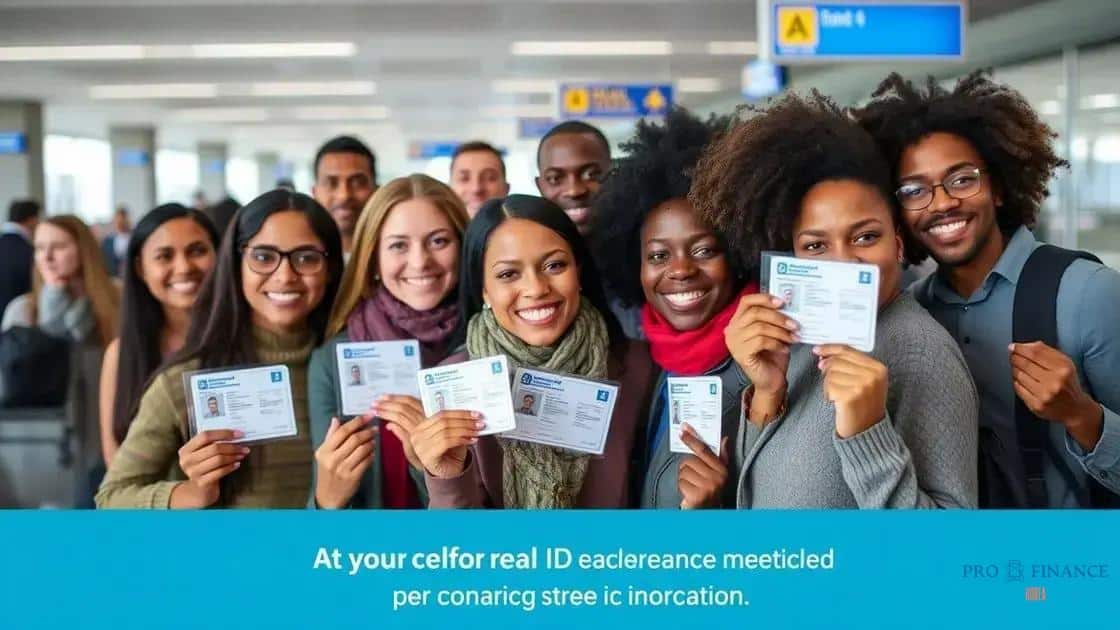Real ID enforcement May 2025: What to expect next

The Real ID enforcement, effective May 2025, requires travelers to have a federally compliant ID for domestic flights and access to federal facilities, enhancing security and identification standards.
Real ID enforcement May 2025 is just around the corner, and many are wondering how it will affect their daily lives. Have you thought about what you need to do to comply? Let’s dive into the details and see how to prepare.
Understanding Real ID and its purpose
The Real ID is a key security measure introduced to enhance identification standards in the United States. It is crucial for all citizens to understand its purpose and implications.
This ID aims to improve national security by ensuring that only individuals who meet specific requirements can obtain identification. By 2025, all air travelers must present a Real ID or an alternative form of ID to board domestic flights.
What is the Real ID?
The Real ID Act establishes minimum security standards for license issuance and production. In essence, it ensures that you have verified your identity, residency, and lawful status.
- Must provide documentation proving your identity
- Requires proof of residency, like a utility bill
- Undocumented individuals will not qualify
Obtaining a Real ID is about more than just flying; it’s an essential step toward accessing various secure facilities and services. Many states have different rules on how to apply for this ID.
Why is Real ID important?
The purpose of the Real ID extends beyond air travel. It aims to prevent identity theft by establishing strict guidelines for issuing IDs. Additionally, it enhances the verification process during various interactions with government agencies.
Many public facilities, including nuclear power plants and federal buildings, will also require a Real ID or other approved identification. Hence, preparing in advance can save you time and hassle.
Key changes with the Real ID in 2025

The upcoming Real ID enforcement in 2025 brings significant changes to identification standards in the U.S. It’s essential for everyone to know what these changes entail.
One of the major shifts is how states will need to comply with federal ID requirements. By May 2025, all states must implement the Real ID standards, meaning travelers will need to have a compliant ID for air travel.
What’s new with the Real ID?
New requirements will ensure that IDs are issued only after a thorough verification process. This means applicants will need to provide more documentation than they might have in the past.
- Verification of citizenship or lawful presence
- Proof of state residency
- Updated photographs that meet strict guidelines
These changes aim to enhance security and reduce identity fraud. With the new rules, people might find that the process of obtaining a Real ID is a bit more involved than before. It’s crucial to gather your documents ahead of time.
Impacts on daily life
Beyond air travel, the Real ID will also impact access to federal facilities. From military bases to nuclear plants, identification compliance will be mandatory. This can affect where you can go and how you interact with government services.
Many people may not realize that their current driver’s licenses may not meet the new standards, highlighting the need for an upgrade to maintain access to essential services.
How to obtain your Real ID
Obtaining your Real ID is a straightforward process, but it requires careful preparation and the right documentation. Knowing the steps to take can help streamline your application.
The first step is to check your state’s requirements, as they may vary slightly. Most states have a dedicated website where you can find detailed information about obtaining a Real ID.
Gather necessary documents
Document requirements are a crucial part of the application. Generally, you will need to provide proof of identity, residency, and legal presence.
- Proof of identity: This can be your birth certificate or a valid passport.
- Proof of residency: Common documents include utility bills or bank statements.
- Legal presence: Documents like a green card or a certificate of naturalization may be required.
Make sure to collect all original documents. Some states will require you to present the documents in person when applying for your Real ID.
Visit your local DMV
Once you have your documents ready, head to your local Department of Motor Vehicles (DMV). It’s advisable to make an appointment if your state allows it to reduce waiting time.
At the DMV, you will fill out an application form and submit your documents. You may also need to pay a fee at this time. Fees vary by state, so check in advance to know what to expect.
After your application is processed, you will receive your Real ID by mail. It’s essential to keep your DMV receipt as a temporary ID until your new card arrives.
Impacts on travel and identification

The changes brought by the Real ID in 2025 will greatly affect travel and identification processes. Everyone who plans to travel domestically should be aware of these impacts.
With the requirement of a Real ID to board commercial flights, travelers are urged to ensure they have the appropriate identification. This will not only streamline the boarding process but also enhance security measures overall.
Traveling by air
Starting in May 2025, standard driver’s licenses will no longer be accepted at airport security checkpoints. Instead, travelers must present a Real ID or another approved form of identification.
- Acceptable IDs include a passport, military ID, or Real ID.
- Travelers without the necessary ID may face delays or be denied boarding altogether.
- It’s important to check expiration dates to avoid any last-minute issues.
This change emphasizes the importance of being proactive about travel plans. Gathering your documents before a trip can save time and frustration.
Identification at federal facilities
The Real ID requirements extend beyond air travel. Access to various federal facilities will also necessitate a compliant form of ID. Facilities like military bases, nuclear power plants, and other secure locations will not allow entry without proper identification.
Being prepared with a Real ID means you can access these essential services without hassle. It also enhances your ability to interact with various government services that may require additional verification.
Common questions about Real ID enforcement
As the Real ID enforcement date approaches, many people have questions. Understanding these commonly asked questions can ease concerns and help you prepare.
One frequent query is whether all states are ready for the Real ID requirements by 2025. Most states are implementing the necessary changes, but it’s wise to verify your state’s status.
What identification is acceptable?
In addition to the Real ID, other forms of acceptable identification for air travel include:
- U.S. passport
- Military ID
- Tribal ID
- Global Entry card
This flexibility allows travelers various options for meeting the new requirements.
What if I don’t have a Real ID?
If you don’t obtain a Real ID in time, you can still use a valid U.S. passport or other approved ID for flights. However, not having a Real ID may prevent you from accessing certain federal facilities.
It is essential to plan ahead to ensure you have the required documentation when traveling or visiting secure locations.
How can I check my ID’s compliance?
Most state DMV websites provide tools for checking whether your current ID meets the new Real ID standards. Contact your local DMV office if you have any uncertainties.
Being informed and prepared will help you navigate any changes smoothly as we approach the enforcement date.
FAQ – Common Questions About Real ID Enforcement
What is the Real ID and why is it important?
The Real ID is a federally compliant form of identification necessary for air travel and accessing certain federal facilities after May 2025.
How do I obtain a Real ID?
You need to gather necessary documents like proof of identity and residency, then apply at your local DMV.
What if I don’t have a Real ID by the deadline?
You can still use an acceptable form of ID like a passport for travel, but a Real ID will be required for federal access.
How can I check if my ID is compliant with Real ID standards?
Visit your state’s DMV website or contact them directly for information on compliance and necessary steps.






